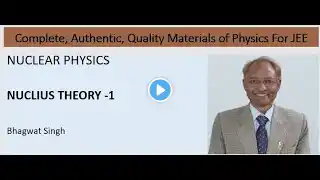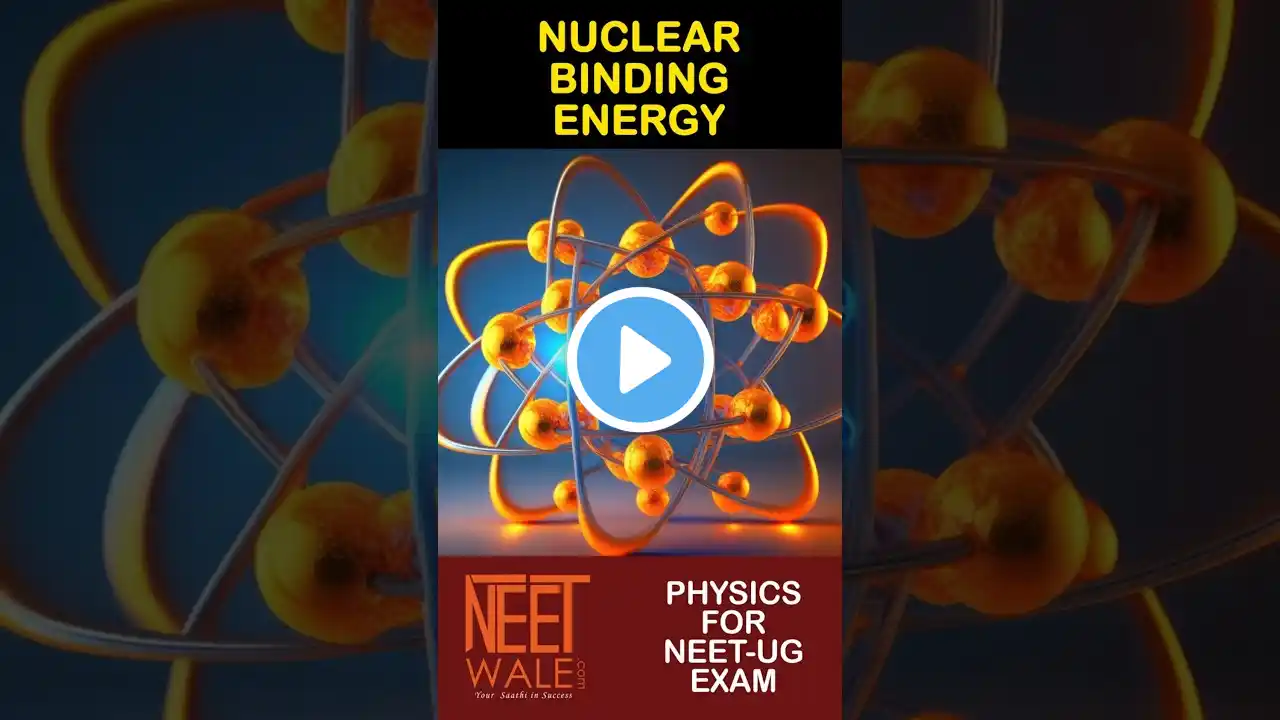
Atoms & Nucleus: Proton & Neutron | Strong Nuclear Force | Nuclear Binding Energy | Physics Class 12
The nucleus is the central part of an atom, comprising protons and neutrons, bound together by the strong nuclear force. It was discovered in 1911 by Ernest Rutherford through his famous gold foil experiment. The nucleus occupies a tiny fraction of the total volume of an atom but contains nearly all of its mass. Constituents of the Nucleus: 1. Protons: Positively charged subatomic particles found in the nucleus. They determine the atomic number of an element and are crucial in defining its chemical properties. 2. Neutrons: Electrically neutral subatomic particles also found in the nucleus. They contribute to the mass of the atom but not to its charge. Neutrons help stabilize the nucleus by counteracting the repulsive forces between positively charged protons. Nuclear Energy: Nuclear energy is the energy released during nuclear reactions. This energy can be harnessed in various ways, primarily through nuclear fission and fusion processes. 1. Nuclear Fission: In nuclear fission, heavy atomic nuclei, such as uranium-235 or plutonium-239, are split into lighter nuclei, releasing a large amount of energy. This process is the basis for nuclear power plants, where controlled fission reactions generate heat to produce steam, which then drives turbines to generate electricity. 2. Nuclear Fusion: Nuclear fusion involves combining light atomic nuclei to form heavier ones, releasing even more energy than fission. Fusion is the process that powers the sun and other stars. It holds immense potential as a future energy source on Earth due to its abundance of fuel (hydrogen isotopes) and its cleaner and safer nature compared to fission. Nuclear Force: The nuclear force, also known as the strong force or strong nuclear force, is one of the fundamental forces of nature. It is responsible for binding protons and neutrons together in the nucleus, overcoming the electrostatic repulsion between positively charged protons. Key points about the nuclear force: 1. Strongest Force at Short Distances: The nuclear force is incredibly strong but operates over very short distances, typically within the range of a few femtometers (10^-15 meters). 2. Residual Force: While the nuclear force primarily acts within the nucleus, it also has a residual effect outside the nucleus, influencing the behavior of nucleons (protons and neutrons) in nearby nuclei. 3. Short-range and Charge-independent: Unlike electromagnetic forces, which decrease with distance and vary with charge, the nuclear force remains relatively constant over short distances and is independent of charge, affecting both protons and neutrons equally. 4. Mesons as Carriers: The nuclear force is mediated by particles called mesons, specifically pions, exchanged between nucleons. These mesons transmit the strong force between protons and neutrons, effectively binding them together. Understanding the nucleus, its constituents, nuclear energy, and the nuclear force is crucial not only for comprehending the structure of matter but also for applications in energy production, medicine (e.g., nuclear medicine), and scientific research. Full Episode Premiere - 23 June 2024 Happy Sunday! Happy Learning!! From - Tirith Learning Centre - The House of Physics Youtube Channel - Rupesh Verma IIT Guwahati Follow me on : YouTube: / @rupesh.verma.iit.guwahati Quora: https://www.quora.com/profile/Rupesh-... Instagram: https://www.instagram.com/rupesh_iit_... Twitter: https://twitter.com/TheCountryBoy26?t... Facebook: / 100002513391295 Rupesh Verma Rupesh Verma IIT Guwahati Rupesh IIT Guwahati Rupesh Verma Sir Rupesh Sir Rupesh Sir IIT Rupesh Sir IIT JEE Rupesh Sir Physics Rupesh Sir Science Rupesh Sir Technolgy IIT Guwahati Happy Sunday Happy Learning Best Science Channel Best Physics Channel Best Science Channel Hindi Best Physics Channel Hindi Best Channel for IIT JEE Preparation Best Channel for IIT JEE Preparation Hindi Best Channel for NEET Preparation Best Channel for NEET Preparation Hindi Science Channel Hindi Physics Channel Hindi NCERT Solution CBSE Class 10 CBSE Class 12 ICSE Class 10 ICSE Class 12 Exam Strategy Exam Prep NEET Motivation Future Doctors IIT Dream IIT Motivation Science Fun Facts Physics Fun Facts JEE Preparation NEET Preparation Engineering Life Engineering World Technology Gyan Atoms Nucleus Protons Neutrons Subatomic particles Strong nuclear force Nuclear binding energy Isotopes Atomic structure Mass number Atomic number Nuclear stability Nuclear reactions Nuclear decay Nuclear physics Nuclear stability Nuclear models Nuclear fusion Nuclear fission Radioactivity Neutron capture Nuclear stability Alpha decay Beta decay Gamma decay Neutron-proton ratio Nucleon Nuclear stability curve Nuclear isomers Nuclear stability regions



















